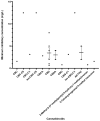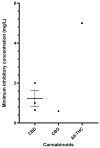Cannabinoids as Antibacterial Agents: A Systematic and Critical Review of In Vitro Efficacy Against Streptococcus and Staphylococcus
- PMID: 39596719
- PMCID: PMC11591022
- DOI: 10.3390/antibiotics13111023
Cannabinoids as Antibacterial Agents: A Systematic and Critical Review of In Vitro Efficacy Against Streptococcus and Staphylococcus
Abstract
Background: Two major bacterial pathogens, Staphylococcus aureus and Streptococcus pyogenes, are becoming increasingly antibiotic-resistant. Despite the urgency, only a few new antibiotics have been approved to address these infections. Although cannabinoids have been noted for their antibacterial properties, a comprehensive review of their effects on these bacteria has been lacking.
Objective: This systematic review examines the antibacterial activity of cannabinoids against S. aureus, including methicillin-resistant S. aureus (MRSA) and vancomycin-resistant S. aureus (VRSA) strains, and S. pyogenes.
Methods: Databases, including CINAHL, Cochrane, Medline, Scopus, Web of Science, and LILACS, were searched. Of 3510 records, 24 studies met the inclusion criteria, reporting on the minimum inhibitory concentration (MIC) and minimum bactericidal concentration of cannabinoids.
Results: Cannabidiol (CBD) emerged as the most effective cannabinoid, with MICs ranging from 0.65 to 32 mg/L against S. aureus, 0.5 to 4 mg/L for MRSA, and 1 to 2 mg/L for VRSA. Other cannabinoids, such as cannabichromene, cannabigerol (CBG), and delta-9-tetrahydrocannabinol (Δ9-THC), also exhibited significant antistaphylococcal activity. CBD, CBG, and Δ9-THC also showed efficacy against S. pyogenes, with MICs between 0.6 and 50 mg/L. Synergistic effects were observed when CBD and essential oils from Cannabis sativa when combined with other antibacterial agents.
Conclusion: Cannabinoids' antibacterial potency is closely linked to their structure-activity relationships, with features like the monoterpene region, aromatic alkyl side chain, and aromatic carboxylic groups enhancing efficacy, particularly in CBD and its cyclic forms. These results highlight the potential of cannabinoids in developing therapies for resistant strains, though further research is needed to confirm their clinical effectiveness.
Keywords: Staphylococcus; Streptococcus; antibacterial; antimicrobial resistance; cannabinoids; dermatological conditions; infection; infectious skin diseases; medicinal cannabis; skin infections.
Conflict of interest statement
Author Indira Samarawickrema is employed by the company Strategy Coaching and Research Consulting Pty Ltd. Author Mahipal Sinnollareddy is employed by the company AbbVie Inc. The remaining authors declare that the research was conducted in the absence of any commercial or financial relationships that could be construed as a potential conflict of interest.
Figures









Similar articles
-
Synthetic Pathways to Non-Psychotropic Phytocannabinoids as Promising Molecules to Develop Novel Antibiotics: A Review.Pharmaceutics. 2023 Jul 5;15(7):1889. doi: 10.3390/pharmaceutics15071889. Pharmaceutics. 2023. PMID: 37514074 Free PMC article. Review.
-
Isolation, Purification, and Antimicrobial Characterization of Cannabidiolic Acid and Cannabidiol from Cannabis sativa L.Biomolecules. 2020 Jun 12;10(6):900. doi: 10.3390/biom10060900. Biomolecules. 2020. PMID: 32545687 Free PMC article.
-
Antimicrobial and antibiofilm effect of cannabinoids from Cannabis sativa against methicillin-resistant Staphylococcus aureus (MRSA) causing bovine mastitis.Int Microbiol. 2024 Dec;27(6):1839-1852. doi: 10.1007/s10123-024-00505-x. Epub 2024 Apr 3. Int Microbiol. 2024. PMID: 38568425
-
A hope for ineffective antibiotics to return to treatment: investigating the anti-biofilm potential of melittin alone and in combination with penicillin and oxacillin against multidrug resistant-MRSA and -VRSA.Front Microbiol. 2024 Feb 1;14:1269392. doi: 10.3389/fmicb.2023.1269392. eCollection 2023. Front Microbiol. 2024. PMID: 38370578 Free PMC article.
-
The Effects of Cannabinoids on Pro- and Anti-Inflammatory Cytokines: A Systematic Review of In Vivo Studies.Cannabis Cannabinoid Res. 2021 Jun;6(3):177-195. doi: 10.1089/can.2020.0105. Epub 2021 Apr 28. Cannabis Cannabinoid Res. 2021. PMID: 33998900 Free PMC article.
Cited by
-
High-Performance Liquid Chromatography with DAD Detection for the Determination of Cannabinoids in Commercial Veterinary CBD Oil.Pharmacy (Basel). 2024 Dec 2;12(6):181. doi: 10.3390/pharmacy12060181. Pharmacy (Basel). 2024. PMID: 39728846 Free PMC article.
-
Exploring the Potential of Phytocannabinoids Against Multidrug-Resistant Bacteria.Plants (Basel). 2025 Jun 20;14(13):1901. doi: 10.3390/plants14131901. Plants (Basel). 2025. PMID: 40647911 Free PMC article.
-
In vitro antimicrobial activity of Thai stick cannabis Hang Kra Rog Phu Phan (Cannabis sativa L.), sugar leaves extract against pathogenic bacteria.J Adv Vet Anim Res. 2025 Mar 24;12(1):44-52. doi: 10.5455/javar.2025.l870. eCollection 2025 Mar. J Adv Vet Anim Res. 2025. PMID: 40568500 Free PMC article.
References
-
- Ikuta K.S., Swetschinski L.R., Aguilar G.R., Sharara F., Mestrovic T., Gray A.P., Weaver N.D., E Wool E., Han C., Hayoon A.G., et al. Global mortality associated with 33 bacterial pathogens in 2019: A systematic analysis for the Global Burden of Disease Study 2019. Lancet. 2022;400:2221–2248. doi: 10.1016/S0140-6736(22)02185-7. - DOI - PMC - PubMed
-
- Bai A.D., Lo C.K., Komorowski A.S., Suresh M., Guo K., Garg A., Tandon P., Senecal J., Del Corpo O., Stefanova I., et al. Staphylococcus aureus bacteremia mortality across country income groups: A secondary analysis of a systematic review. Int. J. Infect. Dis. 2022;122:405–411. doi: 10.1016/j.ijid.2022.06.026. - DOI - PubMed
Publication types
LinkOut - more resources
Full Text Sources
Molecular Biology Databases
Research Materials
Miscellaneous

